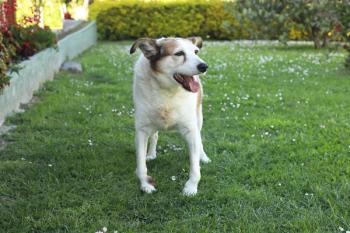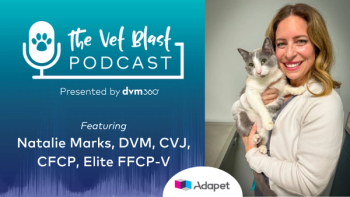
Multi-modal management of arthritis in older dogs and cats (Proceedings)
Osteoarthritis (OA) is a chronic, non-infectious, progressive disorder of any synovial joint. OA is characterized by deterioration of the articular cartilage, synovitis, with secondary bony changes. Osteoarthritis is classified as being primary or secondary in nature.
Osteoarthritis (OA) is a chronic, non-infectious, progressive disorder of any synovial joint. OA is characterized by deterioration of the articular cartilage, synovitis, with secondary bony changes. Osteoarthritis is classified as being primary or secondary in nature. Articular cartilage is a very complex and dynamic structure. The cartilage matrix is composed of proteoglycan macromolecules (hyaluronic acid and GAGs), type 1 collagen, and 80% water. The matrix is synthesized and maintained primarily by the chondrocytes.
Secondary osteoarthritis is a more common cause of clinical lameness in the younger dog. It is the consequence of some external event, angular force adversely affecting the healthy articular cartilage, i.e.; abnormal forces impacting normal cartilage. Examples of secondary OA would include overt trauma, joint incongruity (rupture ACL), and joint misalignment (hip dysplasia). Many feline cases are of secondary origin usually with some historical event that can be attributed to have initiated the process. In order to prevent, halt or minimize the degeneration cascade, the underlying joint incongruity must be corrected when possible.
Conversely, Primary arthritis (age-related) results from abnormalities within the cartilage homeostasis and is considered an intrinsic age–related cartilage homeostasis problem. Unfortunately the affected cartilage has limited ability to regenerate and maintain itself in the face of the cumulative effects of ongoing trauma and/or inflammation. Primary osteoarthritis has a slow progressive course, generally involves one or more joints, and is most common in senior patients. The pathophysiology of primary arthritis involves a series of Pathophysiologic steps that eventually becomes a progressive self-perpetuating process. The mediators of the inflammation, pain, and joint destruction include prostaglandins, cytokines, leukotriens, and kinnins. The variation in clinical response of the each of the various pharmacological agent used in treating OA reflects the specific action of each drug / compound on specific inflammatory mediators and or inflammatory pathway. In primary OA, normal joint forces impact abnormal cartilage resulting in chondrocyte damage, release of inflammatory mediators, synovitis and eventual degeneration of the cartilage and boney structures. Unfortunately the affected cartilage has limited ability to regenerate and maintain itself in the face of the cumulative effects of ongoing trauma and/or inflammation. Primary osteoarthritis has a slow progressive self-perpetuating course, generally involves one or more joints, and is most common type in senior pets. In primary arthritis, there is a shift in the cartilage homeostasis towards the catabolic phase. Initially there is decreased production of proteoglycan by the chondrocytes, a loss of chondroitin sulfates and water from the matrix. The resultant articular cartilage is less elastic with less shock absorption. Any minor trauma produces cartilage fissures and chondrocytes damage. Surface cracks produce "flaking" exposing the collagen fibers to wear and tear. Some cracks extend into the deeper layers and bone produce fibrillation. Degrading enzymes are released which further break down cartilage matrix and collagen. These enzymes include serines, collagenase, cathepsins, metalloproteinase's, hyaluronidases, stromelysins, plus the cartilage breakdown products, initiate a mild synovitis The resulting inflamed synovial membrane releases primary inflammatory mediators IL 1, IL6, tissue necrosis factor, proteases, and prostaglandins that further increasing cartilage destruction and inhibiting new matrix production. The further decreased resiliency of the cartilage results in sclerosis of the subchondral bone and osteophyte development in the periarticular margins in advanced cases.
The clinical signs of osteoarthritis are similar regardless of whether the disorder is primary or secondary. The onset is often insidious but progressive. Early in the course of the disease, the animal may sporadically be reluctant to perform previous tasks or activities, i.e., jumping into the car. In the next stage, a lameness or stiffness occurs following periods of excess activity or overexertion. These signs often disappear after several days of rest. As the degeneration progresses, the stiffness and lameness may be most pronounced following periods of rest. The pet typically "warms out" of the signs with activity. Any cold or damp weather will increase the severity and duration of the symptoms. Continuous stiffness, lameness and chronic pain typify the final stage producing an irritable, reclusive and restless pet.
The exact prevalence of osteoarthritis in cats is unknown. Several studies have demonstrated radiographic evidence of OA in older cats; 90%, 39% and 22%, in the general population. The common locations included the hips, elbows, and spine. In all studies, it was crystal clear that based on the owner's careful observations of their cat's activities and behaviors, the correlation between the radiographic changes and the clinical findings usually found in older dogs, was surprisingly lacking. In older cats, the lesion locations and those symptoms exhibited differ significantly from dogs primarily because the lesion locations and exhibited symptoms differ somewhat. The most common location of OA in older cats was the hips, followed by the elbow and then the spine. Common feline symptoms included changes in jumping habits. Failure to jump was associated with hip arthritis while the failure to jump down was most likely an elbow or spinal problem. Asking "jumping up and jumping down" historical questions is imperative to focusing in on the problem. Remember, in cats, the radiographic findings do not correlate well with the clinical signs exhibited.
Common signs of age-related feline osteoarthritis include; Decreased grooming; Grooming difficulties; Inappropriate eliminations outside the litter box of stool and urine; Difficulty getting in and out of the litter box; Sleep cycle disturbances (day or night), Hiding behavior or reclusiveness; Aggressive when handled, petted or groomed; Inactivity; Plus obvious lameness signs. However the obvious lameness and exercise difficulties observed in dogs, was not often observed with the typical older cat's relaxed lifestyle. In addition, the presenting symptom of overt lameness is also not as common in the feline in part because of their smaller size and innate agility. Plus, bilateral joint involvement (hips or elbows) makes obvious lameness much more difficult to assess in cats. Unfortunately the clinical signs of OA and those behavioral changes that accompany OA are so insidious, so easily missed or often assumed to be those inevitable age-related changes, that cat owners do not seek veterinary help.
Unlike many of the canine cases, on physical examination, the affected joint commonly does not have a decreased range of motion, but will have some palpable periarticular thickening in the advancing cases. Crepitus is also uncommon as is overt synovial effusions. Resistance to manipulation as an indicator of pain is quite variable and does not correlate well with the radiographic findings.
There is no cure for arthritis, only control. The goals in the treatment should be to alleviate patient discomfort, minimize further degenerative changes, and to restore the affected joints to as near normal and pain-free as function possible. The concept of multi-modal management increases the chance of long term success and minimizes possible adverse reactions. The management of arthritis involves the following strategies and should be tailored to best meet the patient and clients needs; 1. Client education on the progressive nature of the disease is critical; 2. Set realistic outcome goals (expectations); 3. Adequate rest periods; 4. Sensible exercise program; 5. Weight assessment and a weight reduction program when necessary; 6.Analgesics and anti-inflammatory therapy for rapid results; and/or 6. Chondroprotectives agents; 7.Anti-oxidant nutritional therapy (supplemental and/or dietary); 8. Physical therapy including a scheduled exercise program; and 9. Complementary therapies, i.e. message therapy, acupuncture, chiropractic, etc.
Cats and dogs with arthritis are less active which leads to being overweight. Being overweight adds additional stresses to the affected joints... a vicious destructive cycle. In overweight pet, caloric restriction helps reduce the stress on joints making the patient more comfortable. As with most arthritic dogs, it may be beneficial to encourage some activity to keep the joints flexible and the muscles conditioned.
Although chondroprotectives agents have strong advocates, when choosing between NSAIDs and a chondroprotectives agent, the NSAIDS have a more consistent, more predictable and faster response that our client expects. In addition NSAIDS have more research documenting the positive benefits and the product quality control / quality assurance is regulated. Unfortunately there are potentially serious side effects associated with chronic NSAID usage that must be communicated with the owners and periodically assessed. Conversely the chondroprotectives provide less reliable relief, are slower to work, but are much less toxic.
NSAIDS have a variable combination of anti-inflammatory, antipyretic, and analgesic effects. The variation in clinical response of the each pharmacological NSAID agent used in treating arthritis reflects the specific effect on various mediators of the inflammation via selective inhibition of pyrogens, COX1, COX2, and pain mediators. NSAIDS toxicity ranks at the very top of the geriatric adverse drug reaction list. Primarily this is because of their wide spread usage and potential life threatening side effects. Adverse Drug Events (toxicity) are usually associated with over dosages, misuse by owners, combined therapy with steroids, failure to "wash-out" a NSAID before switching to another one, concomitant disease, and the lack of pharmaco-vigilance on the veterinarians part.
Most common toxicity associated with the administration of NSAIDS results from Prostaglandin E inhibition. This is often dose-related adverse drug event. Prostaglandin E is gastric cyto-protective by inhibiting gastric acid secretion, maintaining mucosa blood flow, stimulating epithelial cell renewal /restitution, increasing gastric bicarbonate and mucus secretion. Nonselective inhibition of COX can result in gastrointestinal damage, decreased renal blood flow and/or hepatopathies. The resultant toxicity(s) includes gastro-duodenal hemorrhage, gastro-duodenal ulcerations, bleeding dyscrasias, and analgesic nephropathy/hepatopathies. While all NSAIDS have some common acute and chronic toxicity, each compound has unique pharmacological and dosing advantages so they should never be considered either identical or interchangeable. When switching from one NSAID to another, a 7 day "WASH OUT" period is highly recommended. During washout the drug Tramadol at 2-5mg/kg q12h can be used in dogs. It stimulates the opiate, adrenergic, and serotonin receptors. This pain reliever is compatible with all the COX inhibiting NSAIDS drugs but not with serotonin reuptake inhibitors, tricyclic antidepressants, or monoamine oxidase inhibitors such as Selegiline.
Cyto-protective strategies are aimed at eliminating or reducing the possible side effects with prolonged NASAID administration. Using more selective COX2 inhibitors (COX1 sparing), accurate dosing, administering NSAIDs with a meal, the use of concomitant antacids, the use of H2 receptor blockers can all aid in prevent most of the untoward side effects of nonsteroidal anti-inflammatory medication. Misoprostal, a synthetic PGE1 replacement, was first advocated to combat the side effects of NSAIDS. The dosage is 2-5 ug/kg PO TID and is contraindicated in pregnancy.
NSAIDs therapy poses a challenge because of the feline's susceptibility to NSAID toxicity especially with long term usage. Much of these potential problems relate to the drugs longer half-life in cats. As with dogs, a pre-treatment laboratory screening database plus periodic follow-ups screenings would be prudent, although unlike dogs, no standard screening protocol exists. With care, the extra-label meloxicam can be used long term in cats with osteoarthritis at the 0.01 - .003 mg/kg PO SID dosage which is lower than the dosage approved for chronic feline use in Europe. Even at this lower dosage, owners should be instructed to decrease the dosage to the least amount necessary to control their pet's symptoms. Mandatory patient monitoring is essential.
Chondroprotectives agents are a group of compounds that directly benefit and/or support the cartilage matrix. As a group, these compounds act to decrease the breakdown of articular cartilage and/or provide the building blocks to up regulate cartilage synthesis. Some actually decrease inflammation and increase beneficial synovial fluid secretion. Therefore chondroprotectives agents may not only relieve some symptoms but they may also decrease the degenerative process thereby may actually "reverse" the degeneration. Although chondroprotective agents are not considered analgesics, recent studies indicate they may have a direct anti-inflammatory effect on the synovial membrane. Principle components of chondroprotective agents include one or more of the following; PSGAG's, glucosamine, and chondroitin sulfate. Unfortunately clinical failures with chondroprotective therapies are common and could be attributed to minimal cartilage remaining (bone to bone), unresponsive inflammation, time /dose dependant responses, and the lack of analgesia. The low daily dosage of chondroprotective in some diets, there efficacy in treating arthritis is questionable. While more expensive, the injectable PSGAG's give a faster and longer lasting response than the oral forms. Although more expensive, the combination of NSAIDs plus chondroprotective is attractive to many owners, especially if the chondroprotective agent decreases the NSAID dosage and frequency of usage. Glucosamine and chondroitin sulfate are precursors for glycosaminoglycans, proteoglycans, and glycolipids, key components of cartilage. Based on anecdotal reports selected cats and dogs will respond to glucosamine and chondroitin sulfate supplements. However research demonstrating a clear benefit is currently lacking especially in cats. Compared to glucosamine sulfate, and glucosamine NaCL or KCL, glucosamine HCL is the most bioavailability form in dogs and cats.
Glucocorticoids are very effective at decreasing the inflammation associated with arthritis however they should only be used in those advanced cases that are unresponsive to NSAIDS since steroids hasten the cartilage degeneration via chondromalacia. Steroids may be a viable option for those cats in chronic compromised renal failure. PU/PD, GI bleeding and ulceration are common adverse reactions of steroids in dogs, which are amplified when used concomitantly with NSAIDs.
Recent focus has been on the use of a diet as part of an overall arthritis management strategy. Dietary glucosamine and/or dietary Omega 3 fatty acids, especially DHA and EPA, can reduce production of the pro-inflammatory factors and result in clinical improvement is some arthritic patients. Purina, Hills, IAMS, Royal Canin all have arthritis specific dietary formulations.
A wide variety of other nutritional supplements have been used in the management of DJD in small animals including Vitamin C, crysotherapy (gold injections), free radical scavengers orgotein (Palosein), MSN, and hyaluronate sodium. In most cases the exact mechanisms of action is poorly understood and little scientific data exists to determine any efficacy.
In cats osteoarthritis management involves the judicious use of chondroprotective agents, steroids and/or a non-approved long term NSAIDs such as Metacam. In addition, dry milk from hyper immunized cows contains a number of biological active substances including immunoglobulin, cytokines, enzymes, hormones, and growth factors. These compounds impart non-specific anti-inflammatory properties. The exact mechanism has not been well established. There are anecdotal reports of clinical improvement in dogs and especially cats on daily Duralactin® supplementation.
Complementary (adjunctive) therapies continue to gain favor among the veterinary community and the pet owning public in managing arthritis and complements all of the current "western" therapies. Reported positive benefits have been observed with Acupuncture, Chiropractic, PT, and underwater treadmill regimens.
Newsletter
From exam room tips to practice management insights, get trusted veterinary news delivered straight to your inbox—subscribe to dvm360.






